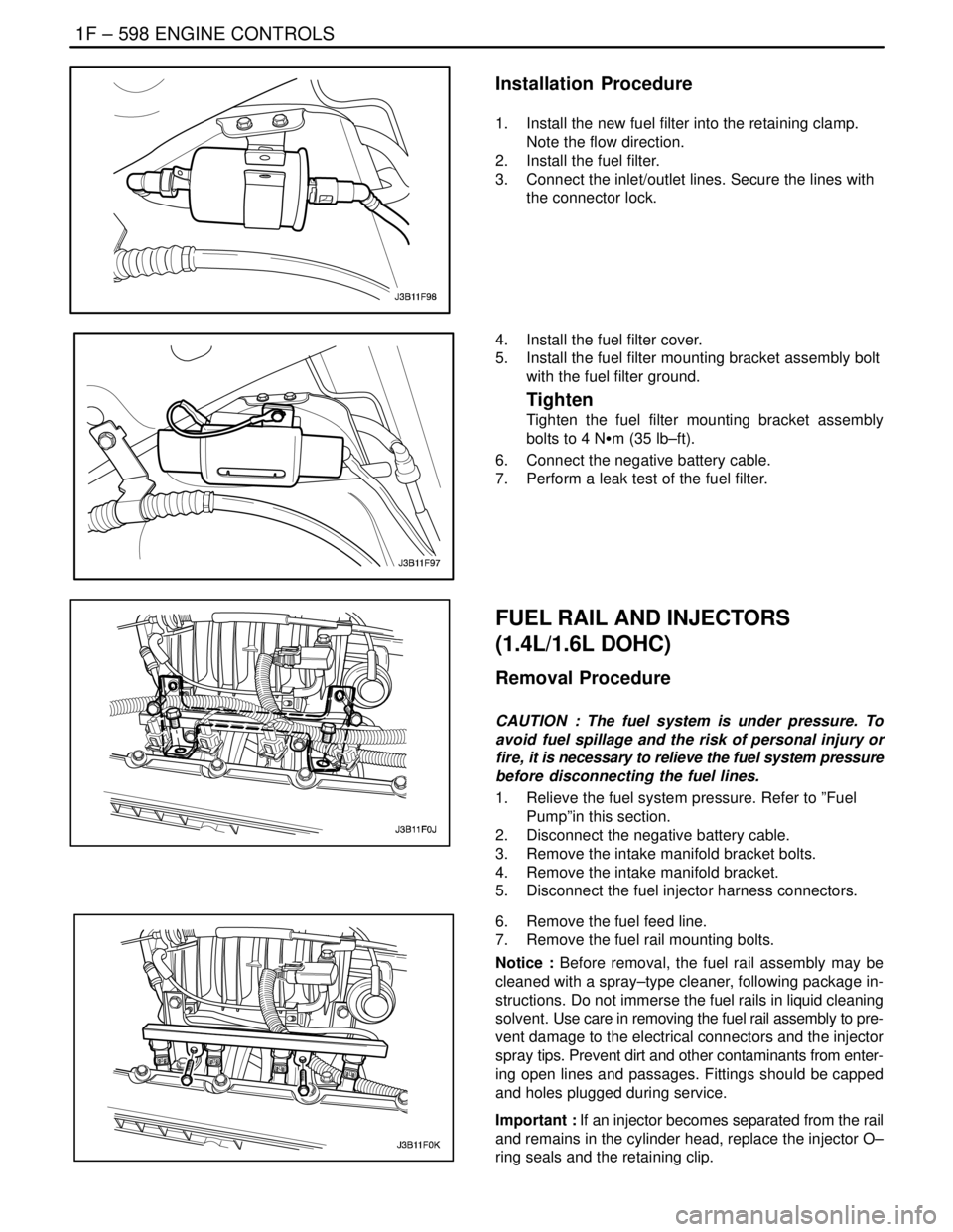2004 DAEWOO LACETTI fuel filter
[x] Cancel search: fuel filterPage 794 of 2643

1F – 548IENGINE CONTROLS
DAEWOO V–121 BL4
DIAGNOSTIC TROUBLE CODE (DTC) P1171
FUEL TRIM SYSTEM LEAN DURING POWER
ENRICHMENT
System Description
The internal circuitry of the Engine control Module (ECM)
can identify if the vehicle fuel system is capable of supply-
ing adequate amounts of fuel during heavy acceleration(
power enrichment). When a Power Enrichment (PE)
mode of operation is requested by heavy acceleration dur-
ing Closed Loop operation, the ECM will provide more fuel
to the engine. Under these conditions the ECM should de-
tect a rich condition. If this reich condition is nor detected
at this time, Diagnostic Trouble Code (DTC) P1171 will set.
A plugged fuel filter or restricted fuel line can prevent ade-
quate amount of fuel from being supplied during Power
Enrichment mode.
Conditions for Setting the DTC
S HO2S1 voltage is less than 0.35 volts in Power En-
richment (PE) mode.
S Engine is operating in Closed Loop and in PE
mode.
S Engine Coolant Temperature (ECT) is greater than
60°C (140°F).
S System voltage is greater than 10 volts.
S Air/Fuel ration is less than 13.5:1.
S DTCs P0106, P0107, P0108, P0117, P0118,
P0122, P0123, P0171, P0172, P0201, P0202,
P0203, P0204, P0300, P0336, P0337, P0351,
P0352, P0402, P0404, P0405, P0406, P0506,
P0507, P1404, and P0443 are not set.
S 3 second delay after in PE mode.
Action Taken When the DTC Sets
S The Malfunction Indicator Lamp (MIL) will illuminate
after two consecutive ignition cycle with a fail.
S The ECM will record operating conditions at the
time the diagnostic fails. This information will be
stored in the Freeze Frame and Failure Records
buffers.
S A history DTC is stored.
S The vehicle will operate in Open Loop.Conditions for Clearing the MIL/DTC
S The MIL will turn off after three consecutive ignition
cycles in which the diagnostic runs without a fault.
S A history DTC will clear after 40 consecutive warm–
up cycles without a fault.
S DTC(s) can be cleared by using the scan tool.
S Disconnecting the ECM battery feed for more than
10 seconds.v
Diagnostic Aids
A restricted fuel filter can supply adequate amounts of fuel
at idle, but may not be able to supply enough fuel during
heavy acceleration.
Water or alcohol n fuel may cause low HO2S1 voltage dur-
ing acceleration.
Check for adequate amount of fuel in the Tank.
When the engine is idling or at steady cruise, the HO2S1
voltage should vary from between approximately a00 to
900 millivolts. During power enrichment mode, more fuel
is needed, and the HO2S1 should rise above 444 milli-
volts.
Check for faulty or plugged injector(s).
Test Description
Number(s) below refer to the step number(s) on the Diag-
nostic Table.
1. The On–Board Diagnostic (EOBD) System Check
prompts the technician to complete some basic
checks and store the freeze frame and failure re-
cords data on the scan tool if applicable. This
creates an electronic copy of the data taken when
the malfunction occurred. The information is then
stored on the scan tool for later reference.
4. This step checks to see if the HO2S1 is operating
properly.
6. If no faults have been found at this point and no
additional DTCs were set, refer to ”Diagnostic Aids”
in this section for additional checks and informa-
tion.
Page 825 of 2643

ENGINE CONTROLS 1F – 579
DAEWOO V–121 BL4
SURGES OR CHUGGLES
Definition : Engine power varies under steady throttle or
cruise, making it feel as if the vehicle speeds up and slows
down with no change in the accelerator pedal position.
Important : Make sure the driver understands Torque
Converter Clutch (TCC) and A/C compressor operation as
described in the owner’s manualThe speedometer reading and the speed reading on the
scan tool should be equal.
Before diagnosing the symptom, check service bulletins
for updates.
Step
ActionValue(s)YesNo
1Were the Important Preliminary Checks performed?–Go toStep 2Go to
”Important Pre-
liminary
Checks”
2Connect the scan tool to the Data Link Connector
(DLC).
Does the Front Heated Oxygen Sensor (HO2S1) re-
spond quickly to different throttle positions?–Go toStep 4Go toStep 3
31. Check the HO2S1 sensor for silicone or other
contaminants from fuel or use of improper
Room Temperature Vulcanizing (RTV) sealant.
2. Replace the contaminated HO2S1 sensor.
Is the repair complete?–System OK–
41. Drive the vehicle at the speed of the complaint.
2. Monitor the long term fuel trim reading using
the scan tool.
Is the long term fuel trim reading within the value
specified?–20–25%Go toStep 7Go toStep 5
5Is the long term fuel trim reading below the value
specified?–20%Go to
”Diagnostic
Aids for DTC
P0172”Go toStep 6
6Is the long term fuel trim reading above the value
specified?25%Go to
”Diagnostic
Aids for DTC
P0171”–
7Check the fuel system pressure while the condition
exists.
Is the fuel system pressure within specifications?41–47 psi
(284–325 kPa)Go toStep 8Go toStep 17
8Check the in–line fuel filter.
Is the filter dirty or plugged?–Go toStep 18Go toStep 9
9Perform an injector diagnosis.
Does the injector balance test pinpoint the problem?–Go toStep 19Go toStep 10
101. Check for proper ignition voltage output using a
spark tester.
2. Inspect the spark plugs for cracks, wear, im-
proper gap, burned electrodes, or heavy de-
posits.
Is the problem found?–Go toStep 11Go toStep 12
11Repair or replace any ignition system components
as needed.
Is the repair complete?–System OK–
Page 826 of 2643

1F – 580IENGINE CONTROLS
DAEWOO V–121 BL4
StepNo Yes Value(s) Action
121. Inspect the engine control module (ECM)
grounds to make sure they are clean, tight, and
in their proper locations.
2. Inspect the vacuum lines for kinks or leaks.
Is the problem found?–Go toStep 13Go toStep 14
13Repair the electrical connections or the vacuum
lines as needed.
Is the repair complete?–System OK–
14Check the generator output voltage.
Is the generator voltage within the value specified?12–16 vGo toStep 16Go toStep 15
15Repair the generator.
Is the repair complete?–System OK–
161. Check for intermittent Exhaust Gas Recircula-
tion (EGR) valve operation.
2. Check Torque Converter Clutch (TCC) opera-
tion.
3. Repair or replace any components as needed.
Is the repair complete?–System OK–
17Repair the fuel system as needed.
Is the repair complete?–System OK–
18Replace the fuel filter.
Is the repair complete?–System OK–
19Replace the leaking or restricted fuel injectors.
Is the repair complete?–System OK–
Page 827 of 2643

ENGINE CONTROLS 1F – 581
DAEWOO V–121 BL4
LACK OF POWER, SLUGGISHNESS, OR SPONGINESS
Definition : The engine delivers less than expected power. There is little or no increase in speed when the accelerator pedal
is partially applied.
Step
ActionValue(s)YesNo
1Were the Important Preliminary Checks performed?–Go toStep 2Go to
”Important Pre-
liminary
Checks”
21. Verify the customer’s complaint.
2. Compare the performance of the customer’s
vehicle with a similar unit.
Does the problem exist?–Go toStep 3System OK
31. Inspect the air filter for excessive contamina-
tion.
2. Replace the air filter as needed.
3. Check the transaxle shift pattern and downshift
operation.
Does the transaxle operate properly?–Go toStep 4Go toStep 5
4Check the fuel system pressure.
Is the fuel system pressure within specifications?41–47 psi
(284–325 kPa)Go toStep 7Go toStep 6
5Repair the transaxle as needed.
Is the repair complete?–System OK–
6Repair the fuel system as needed.
Is the repair complete?–System OK–
7Check for a restricted fuel filter or contaminated fuel.
Is the problem found?–Go toStep 8Go toStep 9
8Repair or replace any components as needed.
Is the repair complete?–System OK–
91. Check the ignition system output for all of the
cylinders using a spark tester.
2. Check for proper ignition control operation.
Is the ignition system operating properly?–Go toStep 10Go toStep 11
101. With the engine at normal operating tempera-
ture, connect a vacuum gauge to a vacuum
port on the intake manifold.
2. Operate the engine at 1,000 rpm.
3. Record the vacuum reading.
4. Increase the engine speed to 2,500 rpm.
5. Note the vacuum reading at a steady 2,500
rpm.
Does the vacuum decrease more than the value
specified?10 kPa
(3 in. Hg)Go toStep 12Go toStep 15
11Repair or replace any ignition system components
as needed.
Is the repair complete?–System OK–
12Inspect the exhaust system for restrictions and dam-
aged or collapsed pipes.
Is the problem found?–Go toStep 13Go toStep 15
13Repair or replace any components as needed.
Is the repair complete?–System OK–
Page 831 of 2643

ENGINE CONTROLS 1F – 585
DAEWOO V–121 BL4
StepNo Yes Value(s) Action
71. Perform a cylinder compression test.
2. If the compression is low, repair the engine as
needed.
3. Inspect for proper valve timing, bent pushrods,
worn rocker arms, broken or weak valve
springs, and worn camshaft lobes.
4. Inspect the intake manifold and the exhaust
manifold passages for casting flash.
Is the problem found?–Go toStep 8Go toStep 9
8Repair or replace any components as needed.
Is the repair complete?–System OK–
91. Check the fuel system for a plugged in–line fuel
filter.
2. Check the fuel system for low fuel pressure. If
the fuel pressure is below the value specified,
service the fuel system as needed.
3. Inspect for contaminated fuel.
Is the problem found?41–47 psi
(284–325 kPa)Go toStep 10Go toStep 11
10Repair or replace any components as needed.
Is the repair complete?–System OK–
111. Disconnect all of the fuel injector harness con-
nectors at the fuel injectors.
2. Connect an injector test light to the harness
terminals of each fuel injector connector.
3. Note the test light while cranking the engine for
each fuel injector.
Does the test light blink for all of the fuel injectors?–Go toStep 13Go toStep 12
121. Repair or replace the faulty injector drive circuit
harness, the connector, or the connector termi-
nal.
2. If the harness, the connectors, and the termi-
nals are OK, replace the engine control module
(ECM).
Is the repair complete?–System OK–
13Measure the resistance of each fuel injector. The re-
sistance will increase slightly at higher tempera-
tures.
Is the injector resistance within the value specified?11.6–12.4 ΩGo toStep 15Go toStep 14
14Replace any fuel injectors with a resistance that is
out of specifications.
Is the repair complete?–System OK–
15Perform an injector balance test.
Is the problem found?–Go toStep 16Go toStep 17
16Replace any restricted or leaking fuel injectors.
Is the repair complete?–System OK–
Page 833 of 2643

ENGINE CONTROLS 1F – 587
DAEWOO V–121 BL4
POOR FUEL ECONOMY
Definition : Fuel economy, as measured by an actual road
test, is noticeably lower than expected. Also, fuel econo-
my is noticeably lower than it was on this vehicle at one
time, as previously shown by an actual road test.
Important : Driving habits affect fuel economy. Check the
owner’s driving habits by asking the following questions:1. Is the A/C system (i.e. defroster mode) turned on
all the time?
2. Are the tires at the correct air pressure?
3. Have excessively heavy loads been carried?
4. Does the driver accelerate too much and too often?
Suggest the driver read the section in the owner’s
manual about fuel economy.
Step
ActionValue(s)YesNo
1Were the Important Preliminary Checks performed?–Go toStep 2Go to
”Important Pre-
liminary
Checks”
21. Inspect the air filter for excessive contamina-
tion.
2. Inspect for fuel system leaks.
Are all needed checks complete?–Go toStep 3–
31. Inspect the spark plugs for excessive wear,
insulation cracks, improper gap, or heavy de-
posits.
2. Replace any faulty spark plugs.
3. Inspect the ignition wires for cracking, hard-
ness, and proper connections.
Are all needed checks and repairs complete?–Go toStep 4–
41. Inspect the engine coolant level.
2. Check the thermostat for being always open or
for an incorrect heat range.
3. Replace the thermostat as needed.
Are all needed checks and repairs complete?–Go toStep 5–
51. Check the transaxle shift pattern. Ensure all
transaxle gears are functioning.
2. Check the Torque Converter Clutch (TCC) op-
eration with a scan tool. The scan tool should
indicate rpm drop when the TCC is command-
ed on.
3. Check for proper calibration of the speedome-
ter.
4. Check the brakes for dragging.
5. Check the cylinder compression.
6. Repair, replace, or adjust any components as
needed.
Are all checks and needed repairs complete?–System OK–
Page 843 of 2643

ENGINE CONTROLS 1F – 597
DAEWOO V–121 BL4
8. Turn the lock ring counterclockwise to clear the
tank tabs.
9. Remove the fuel pump assembly from the tank.
Installation Procedure
1. Clean the gasket mating surface on the fuel tank.
2. Position the new gasket in place.
3. Install the fuel pump into the fuel tank in the same
location as removed for ease of line and connector
installation.
4. Position the lock ring in place and turn it clockwise
until it contacts the tank stop.
5. Connect the fuel pump assembly connector.
6. Install the fuel pump outlet line.
7. Install the fuel tank return line.
8. Install the fuel pump access cover.
9. Connect the negative battery cable.
10. Perform an operational check of the fuel pump.
11. Install the rear seat. Refer to Section 9H, Seats.
FUEL FILTER
Removal Procedure
CAUTION : The fuel system is under pressure. To
avoid fuel spillage and the risk of personal injury or
fire, it is necessary to relieve the fuel system pressure
before disconnecting the fuel lines.
1. Relieve the fuel system pressure. Refer to ” Fuel
System Pressure Relief ” in this section.
2. Disconnect the negative battery cable.
3. Remove the fuel filter mounting bracket assembly
bolt.
4. Remove the fuel filter cover.
5. Disconnect the inlet/outlet fuel lines by moving the
line connector lock forward and pulling the hose off
of the fuel filter tube.
Page 844 of 2643

1F – 598IENGINE CONTROLS
DAEWOO V–121 BL4
Installation Procedure
1. Install the new fuel filter into the retaining clamp.
Note the flow direction.
2. Install the fuel filter.
3. Connect the inlet/outlet lines. Secure the lines with
the connector lock.
4. Install the fuel filter cover.
5. Install the fuel filter mounting bracket assembly bolt
with the fuel filter ground.
Tighten
Tighten the fuel filter mounting bracket assembly
bolts to 4 NSm (35 lb–ft).
6. Connect the negative battery cable.
7. Perform a leak test of the fuel filter.
FUEL RAIL AND INJECTORS
(1.4L/1.6L DOHC)
Removal Procedure
CAUTION : The fuel system is under pressure. To
avoid fuel spillage and the risk of personal injury or
fire, it is necessary to relieve the fuel system pressure
before disconnecting the fuel lines.
1. Relieve the fuel system pressure. Refer to ”Fuel
Pump”in this section.
2. Disconnect the negative battery cable.
3. Remove the intake manifold bracket bolts.
4. Remove the intake manifold bracket.
5. Disconnect the fuel injector harness connectors.
6. Remove the fuel feed line.
7. Remove the fuel rail mounting bolts.
Notice : Before removal, the fuel rail assembly may be
cleaned with a spray–type cleaner, following package in-
structions. Do not immerse the fuel rails in liquid cleaning
solvent. Use care in removing the fuel rail assembly to pre-
vent damage to the electrical connectors and the injector
spray tips. Prevent dirt and other contaminants from enter-
ing open lines and passages. Fittings should be capped
and holes plugged during service.
Important : If an injector becomes separated from the rail
and remains in the cylinder head, replace the injector O–
ring seals and the retaining clip.